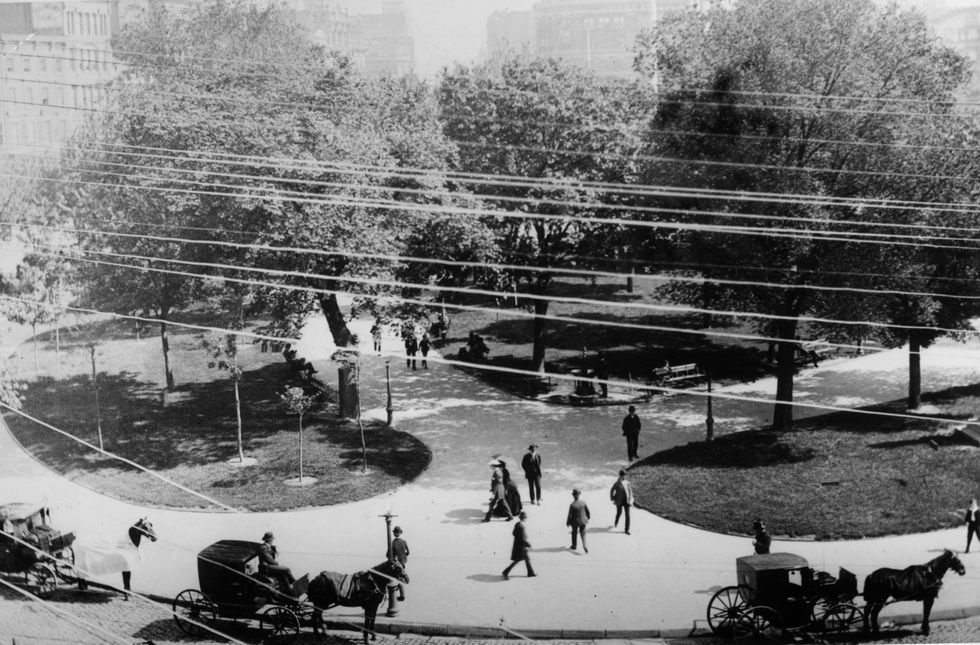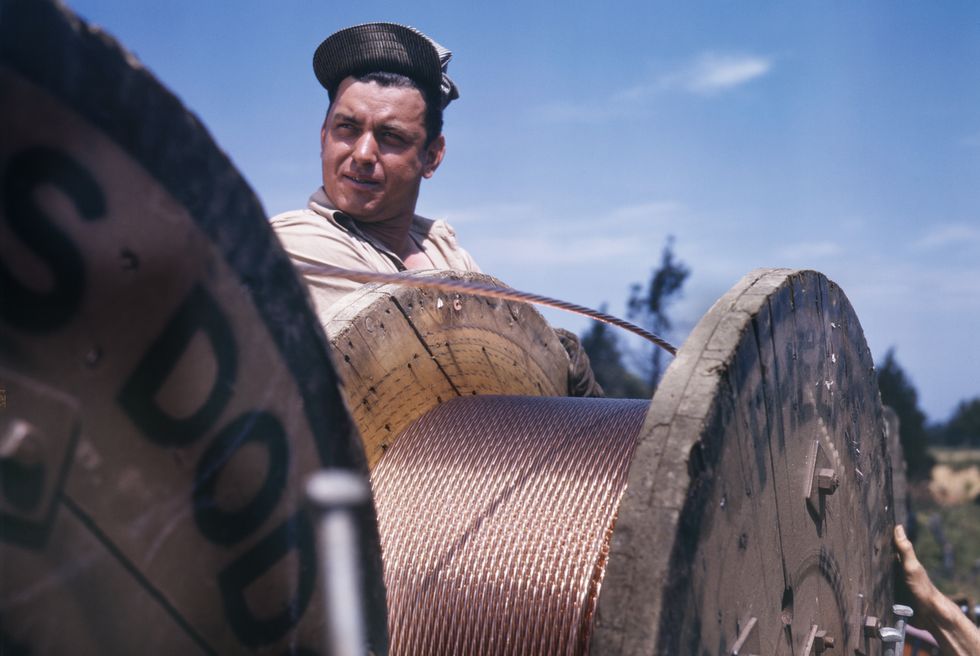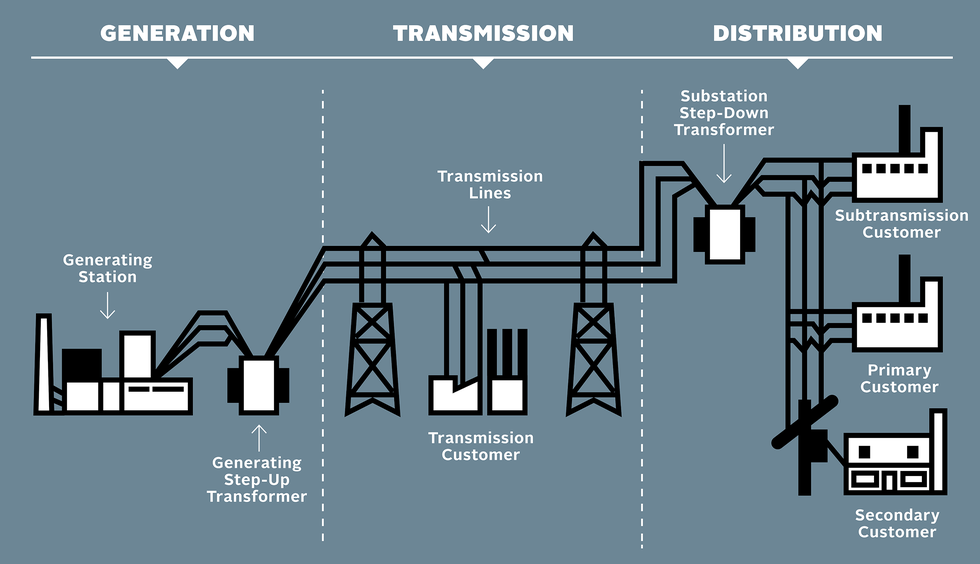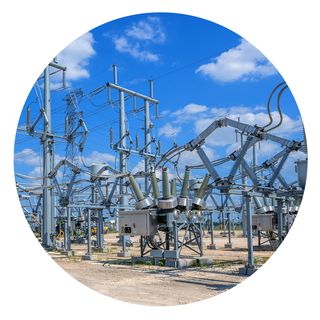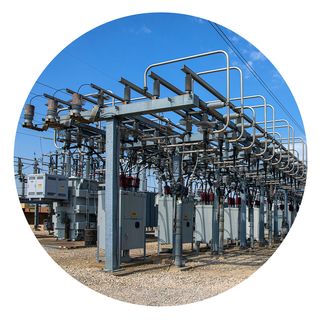What is the largest machine in the world? The Liebherr R9800, the world’s largest excavator, is a good guess. NASA’s crawler-transporter, the tank-like mechanical monster that carts around rockets at Cape Canaveral, is another serious contender. Turns out the world’s largest machine is right outside your front door. You probably see it when you go to the grocery store. In fact, you’re probably using it right now.
The North American Power Grid — which is actually a patchwork of five smaller interconnections — is considered by some to be the biggest machine humanity has ever created. The U.S. alone contains 600,000 miles of transmission lines and 5.5 million miles of distribution lines (those black wires that feed power to your home). By all accounts, it’s a stunning engineering achievement, but it’s one that’s never truly completed.
For the U.S. to meet its increasing electricity needs as cars, homes, and businesses ditch fossil fuels for green energy, the grid needs to keep up with demand. Not only does that mean updating existing infrastructure while investing in more capacity but also defending this sprawling, vulnerable grid from everything from tornadoes to terrorists.
The U.S. electric grid isn’t a monument to past ingenuity but a challenge to our own. Here’s how this machine grew from a small power station in New York City to a continent-spanning mega-project; how the power grid works and delivers electricity to your home; and how it desperately needs to prepare for the energy battle ahead.
Let There Be Light
At 3 p.m. on September 4, 1882, an engineer working at a power station in downtown Manhattan closed a circuit breaker, and within seconds, six coal-powered, 27-ton, 100-kilowatt dynamos roared to life. Providing direct current (DC) power to residents within roughly one-quarter of a mile, Thomas Edison’s Pearl Street Station — the first power station in the world — supplied light to 400 lamps belonging to some 85 initial customers.
Today, 400 lamps seems like an inauspicious debut, but that simple flick of a switch changed life on Earth forever. The moment represented the culmination of centuries of electrical breakthroughs as scientists began to understand electrostatic charge and electromagnetism, while engineers built capacitors, batteries, and eventually entire power stations. This particular summer afternoon in New York City represents the beginning of the U.S. power grid.
Within just 140 years, those 400 lamps transformed into 4.24 trillion kWh of annual electricity. How did this one New York power station transform into the engineering marvel that makes our modern life possible?
Although Pearl Street Station began a new era, the bright future of artificial illumination first needed to survive the “War of the Currents.” In one corner, Edison’s DC tech already proved its worth but couldn’t be transmitted long distances because at the time, engineers couldn’t increase its voltage after generation. Because of this technological limitation, power stations would need to be as frequent as mailboxes throughout cities and towns. Downtown New York, for example, became a jungle of cross beams and electrical wires, with one eyewitness saying at the time, “there were forests of poles downtown… and firemen had the greatest difficulty in raising their ladders.”
But another inventor and former Edison employee named Nikola Tesla — backed by inventor and entrepreneur George Westinghouse — devised an induction motor using “alternating current,” or AC, which was easier to generate and experienced less energy loss because its voltage could be increased and decreased thanks to transformers. The war raged through the end of the 1880s — with a few unsavory bits involving public electrocutions — but AC slowly pulled ahead.
In the 1890s, several AC generating stations in Colorado, Oregon, and California began providing long-distance power to residents. In 1892, Edison Electric joined forces with an AC power competitor and formed General Electric. The following year, the Westinghouse Corporation won approval to power the World’s Columbian Exposition with alternating current.
As the War of the Currents went from a boil to a simmer, electrical generation exploded throughout the country. Many electric plants dotted cities throughout the U.S., providing power to new inventions like trolleys, but it was in Chicago where a glimpse of the modern electrical system began to take shape.
The person who led the U.S. power grid into the future was entrepreneur and businessman Samuel Insull. When Insull arrived in Chicago in 1892, the city was powered by 20 different electric companies. After becoming president of the Chicago Edison company, Insull quickly increased load factor, adopted more efficient steam turbines, became a proponent of AC power, and quickly bought up other companies to turn competitor power stations into substations. Within 15 years, Insull bought more than a dozen power utilities and rechristened his company the Commonwealth Edison — the most progressive and lowest cost utility in the world.
Many electric utilities soon copied Insull’s success, and as these companies grew, they became feared as unwieldy monopolies. But because of the massive investments needed to be a utility, economists saw these growing titans of energy as “natural monopolies,” where the ability to leverage the power of massive turbines required mass amounts of capital. Governments responded by creating municipal or state-regulated utilities, and as the U.S. became more and more electrified, President Franklin Roosevelt passed a series of regulations to promote competition while expanding electricity to rural areas where utilities saw little or no profit.
Finally, on the eve of World War II, the U.S.’s modern electric grid began to take shape. To avoid blackouts and electric shortages, the federal government began demanding interconnections between utility companies. This meant if there was a power shortage in Boston, electricity generated in Ohio could pick up the slack. By the 1960s, the Eastern and Western interconnections (along with the smaller and politically motivated Texas Interconnection) supplied most of the U.S.’s power. Although these two major grids are synchronized, they only have limited connections between them (except for a brief 8-year period when the U.S. electric grid was truly coast-to-coast).
Throughout the 20th century, advancements in raising and lowering DC voltage improved greatly when finally, in 1990, the first major high-voltage direct current (HVDC) system began supplying power to New England. HVDC systems can be more expensive as they require converters at both the power plant and local substations, but electricity can travel longer distances more efficiently than high-voltage AC (HVAC) systems. Today, HVDC is preferred when electricity needs to travel farther than 400 miles or so — a small consolation prize for Thomas Edison.
How the Power Grid Works
Although the power grid has grown in size and complexity from its late 19th century origins, its overall function remains largely the same (albeit with more efficient and powerful components in place). Because the ability to store energy is complex and expensive, electricity is generated on demand, meaning the volts powering a lightbulb in your house were generated microseconds earlier at a power plant possibly hundreds of miles away as electromagnetic waves propagate along wires at the speed of light. To get from the power plant to your home, the power grid operates in three stages: generation, transmission, and distribution.
Generation
Power stations use secondary energy sources, originally coal but more and more frequently natural gas or fission, to create steam and spin turbines that generate electricity using electromagnetic induction. With electricity generation responsible for 31 percent of the U.S. carbon footprint (the largest source in the country), green energy policies push to replace fossil fuels like coal, oil, and natural gas with clean alternatives like solar, wind, hydro, or nuclear.
These electrical turbines create what’s known as three-phase AC power. With the sine wave of an alternating current usually oscillating 60 times (hertz) per second, energy experiences peaks and valleys. This is fine for our homes and most simple equipment, but power-hungry machinery requires three-phase AC power. Offsetting the sine waves by 120 degrees ensures that power is always approaching a peak at any given time.
Power stations then relay this three-phase AC power to a transformer at the plant itself that steps up the voltage for transmission, ranging anywhere from 155,000 to up to 500,000 volts and beyond. The higher the voltage the lower the current, which means the lower the energy resistance through a conductor.
Transmission
With a transformer stepping up the energy, transmission lines carry that high-voltage energy to substations spread across hundreds of miles (way better than Edison’s original one-quarter mile). These transmission towers often carry four (or seven) wires with each set of three wires carrying one of the three AC phases, with the seventh being a ground wire for lightning protection. Along with these wires, transmission towers also have large porcelain or ceramic disk insulators to connect the conducting wires to the tower.
Although these gargantuan towers are often considered unsightly (some countries have even tried to class them up a bit), their large size provides many safety benefits. The most obvious is that it protects people and motorists from getting too close to the wires and possibly creating an electric arc; the resulting arc flash can cause fires and even death. Similarly, the widely spaced wires allow air to insulate the conductors, which also prevents an arc flash. Being essential that these conductors stay away from any possible debris, transmission lines are often placed in open fields or given plenty of room through a cleared section of forest.
Distribution
After traveling these high-voltage transmission lines, electricity arrives at a local substation. You’ve likely seen these fenced off areas that look like a madcap collection of electrical pylons perfectly suited for some mad scientist’s laboratory. Although these substations have a lot of complicated functions, including circuit breakers for disconnecting from the electric grid or from specific distribution lines, the end result is high-voltage electricity is stepped down to less than 10,000 volts (usually around 7,200 volts) and passed to a distribution bus and then onto separate distribution lines. These are the wires that eventually arrive outside your home, whether on utility poles or buried underground.
Finally, a single-phase wire runs outside your home, and a distribution transformer steps down voltage one last time from a few thousand volts to the typical 240 volts that your home requires. From there, the house’s circuit breaker routes electricity to outlets while protecting the home from overloads. A smart meter located outside your home keeps track of how much energy you use and bills you every month accordingly.
Bird on a Wire | With so many volts running through transmission and distribution lines, why are birds not regularly roasted while sitting on utility poles and wires? Simply put, electricity is the movement of electrons flowing from one electrical potential to another. Because birds are at the same potential as the wire, our feathered friends don’t get a nasty shock as electricity stays in the wire. But just because birds are perched on wires all day doesn’t mean they’re entirely safe. Sometimes, a bird will sit on a utility pole while simultaneously touching a wire. Because the pole is grounded to the Earth, the electricity will travel through the bird to the ground. A 2014 study estimates that 11.6 million birds die annually from electric shock in the U.S. Placing conductors further apart, installing insulation, and building pole-top extensions for safer perching can help keep birds from an electrifying end while also improving grid reliability. In 2022, a single bird caused 10,000 customers to lose power in New Orleans — further evidence that a bird-friendly grid is a human-friendly grid.
One Grid, Many Adversaries
The U.S. electric grid is a modern engineering marvel, but like other U.S. megaprojects, the system is showing its age. The Biden Administration estimates that 70 percent of the power grid is over 25 years old, and the grid also needs to increase current capacity by 2050 to keep up with energy needs. Crucially, the U.S. needs to add at least 60 percent more transmission lines to deliver an increasing amount of clean energy from the sunny and windy interior of the U.S. to communities along the coast. You can build out clean energy generation as much as you’d like, but without enough infrastructure to transmit that energy, it’s useless.
Capacity is only one challenge facing the electric grid, the other is the fact that utilities are an easy target for cyberattacks. The electric grid is the most tantalizing target for any country wanting to wreak havoc on the U.S. due to its immense size and importance to everyday life. The problem is exacerbated by the introduction of the “smart grid” and the “industrial internet of things,” which has increased efficiency and reliability while marrying industrial control systems with the internet — opening up the grid to a whole host of potential vulnerabilities.
A cyberattack on a utility in Ukraine left people without power in 2015, while another attack impacted Israel’s water utility in 2020. The following year, the U.S. Energy Secretary confirmed that the U.S’s adversaries likely have the ability to shut down the U.S. electric grid. A report from 2021 details that utility companies need to implement threat detection, coordinate with government agencies on cyberattack response and recovery, and make energy systems more resilient (among other things).
But the biggest looming threat to the electric grid, one that likely makes the system’s other challenges even worse, is climate change. Extreme weather events like wildfires, hurricanes, and deep freezes like the one that sent Texas into a crisis in 2021 (though the Texas interconnection is its own mess) will become the norm, and the electric grid will need to be hardened in order to roll with these environmental punches.
Powering the Future
So what does the power grid of the future look like? Well, the current plan is to create a 100 percent clean energy system by 2035, and to reach that ambitious goal, the U.S. will likely need to build new clean energy systems, invest in next-generation nuclear fission technologies, and continue contributing to international collaborations to develop the holy grail of clean energy systems: nuclear fusion. Meanwhile, it’s also essential that the U.S. grid increases capacity and resiliency, whether against hackers or an increasingly tempestuous climate.
But other innovations will also be needed to make sure the electric grid is completely future-proof. One big area of investment is developing efficient methods to store energy to make the grid more responsive when the sun isn’t shining or the wind isn’t blowing. This could include conventional lithium-ion batteries or more novel ideas, such as gravity batteries or iron-air batteries that tap into the energy-storing potential of oxidation (aka rust).
The U.S. Energy Department’s National Renewable Energy Laboratory has also recommended tying together the U.S.’s three disparate interconnections. A true national grid system that leverages the power of increasingly affordable HVDC transmission lines could ferry solar power from sunny California to snow-covered New England and make the grid even more resilient against natural disasters. Conversely, additional microgrids powering important infrastructure like hospitals could make sure that power outages don’t impact crucial health services.
But the biggest challenge will be updating the already aging energy infrastructure while increasing capacity as the U.S. begins to electrify its cars, stovetops, furnaces, and basically everything else.
For 140 years, the U.S. power grid has completely revolutionized life, but it’s not a one-and-done creation. It requires constant care, vigilance, and innovation to make sure it continues to improve the lives of the people who use that energy, along with the planet we all call home.
Darren lives in Portland, has a cat, and writes/edits about sci-fi and how our world works. You can find his previous stuff at Gizmodo and Paste if you look hard enough.

